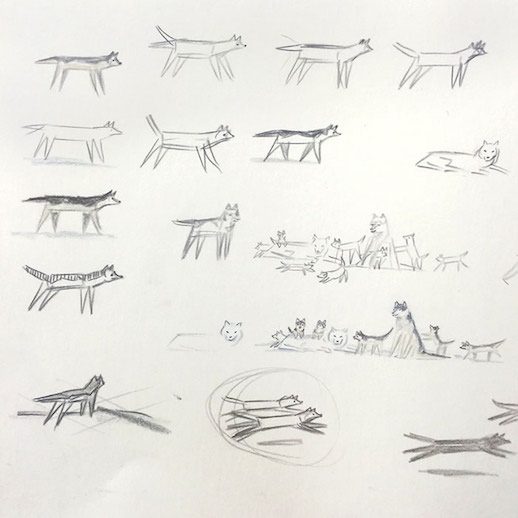When Max Porter declares something “an instant classic”, we reckon you’d be daft to ignore him. These were the words he used to describe The Wolves of Currumpaw, a terrific book which we, in turn, have fallen in love with. Here, along with a brief Q&A, is a selection of sketches by the book’s artist/author William Grill:
Can you say something about your background – where you grew up/whether your parents were artistic? What about your University course and other experiences that have fed into your work?
I grew up in a rural part of Hampshire, so spent a good deal of time outdoors making dens and the like – I think that’s why I’m now so interested in stories that take place in wild places. My parents weren’t particularly artistic, but they were into travelling as both of their backgrounds were in geography. I hate to admit it but I probably looked up to my older brother as he’s always been artistic and a few steps ahead.
Who are your influences?
Influences change all the time, but a few consistent ones would be the Fauvist painters, as well as Eric Ravilious and Saul Steinberg.
What inspired you to write the story of The Wolves of Currumpaw?
I picked up a 1904 copy of Ernest Seton’s classic Wild Animals I Have Known on a whim, and after reading Lobo’s tale I couldn’t put it out of my mind. The story seemed so timeless and relevant to today that I was surprised it wasn’t more well known. This combination was enough to convince myself to try and adapt it visually for a modern audience.
Who was Lobo?
Lobo was one of the last ‘outlaw wolves’ that terrorised a handful of ranchers and cowboys in Clayton, New Mexico in the 1890s. To the frustration of many men, he evaded capture and poisoning countless times, earning him the title ‘The King of Currumpaw’.
Tell us about Ernest Seton.
Ernest Thompson Seton was a talented artist, writer and naturalist. He was also a skilful hunter who knew how to catch wolves better than most, he even wrote a manual for doing so. After his encounter with Lobo, however, his life changed and he never killed a wolf again, and in fact he spent the rest of his life trying to protect wildlife. Apart from lobbying for wildlife protection laws, Seton realised that one of the best ways to do this was through education, and this is how the Boy Scouts of America was formed. You could argue that he was one of the first conservationists.
I understand you spent time at a wolf sanctuary. Tell us a little about your experience there.
I spent a week volunteering at the wolf sanctuary, helping out with odd jobs (mostly weeding) so that I could fill a sketchbook with observational drawings of the wolves. The drawings were done in the morning when the wolves were having breakfast, as that’s when they’re most active. The best moment was hearing all of them howl in chorus at dawn and dusk – and the worst was finding a black widow spider in my jacket. I wished I could have stayed longer, as I had to leave just as I was getting to know the place and the people. But hopefully I’ll pay them another visit soon!
How long did you spend in the US (New Mexico)?
Just under a month.
You use sketchbooks widely. Do you ever use photographs too when you’re working on the finished piece?
I try to use my own reference as much as possible, but sometimes you need to use photos for specific details and imagery you’re not able to see first hand.
I see one of your sketchbooks went missing. Has it reappeared?
Sadly it’s still missing. It contains all my drawings from the wolf sanctuary so it’s a big loss to me, another reason to go back there!
*
The Wolves of Currumpaw is published by Flying Eye Books, and is available here in the Caught by the River shop, priced £14.99.






